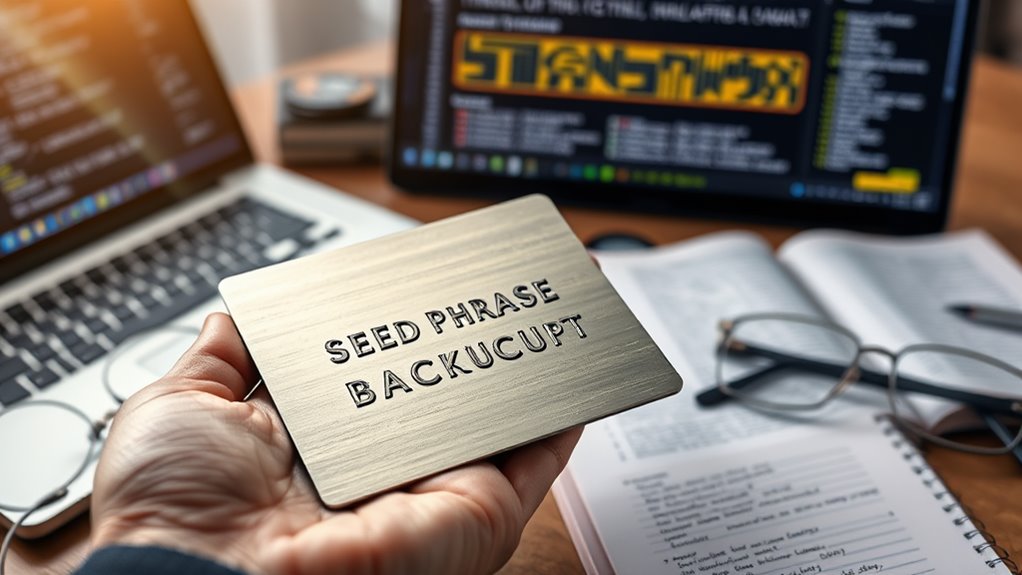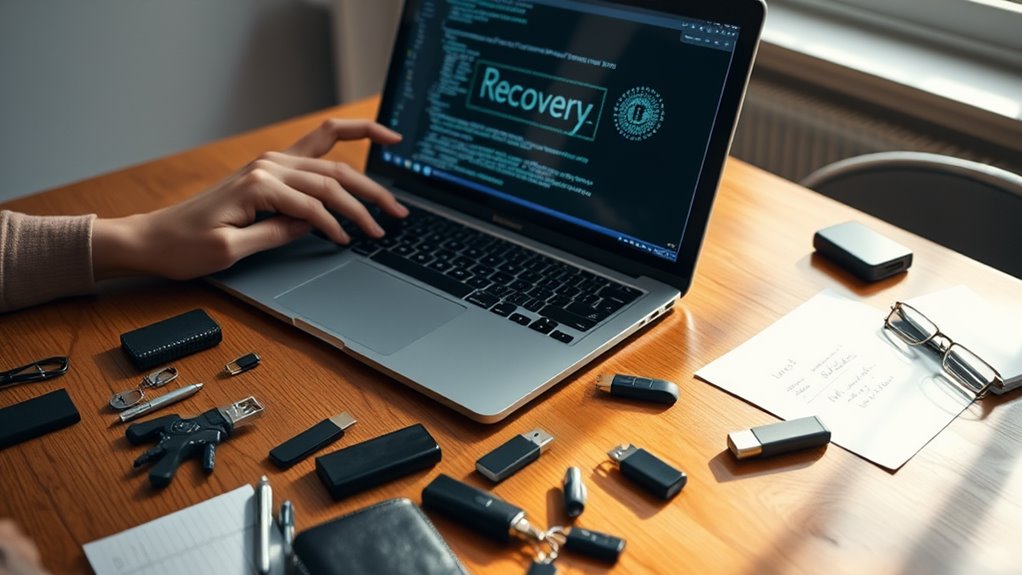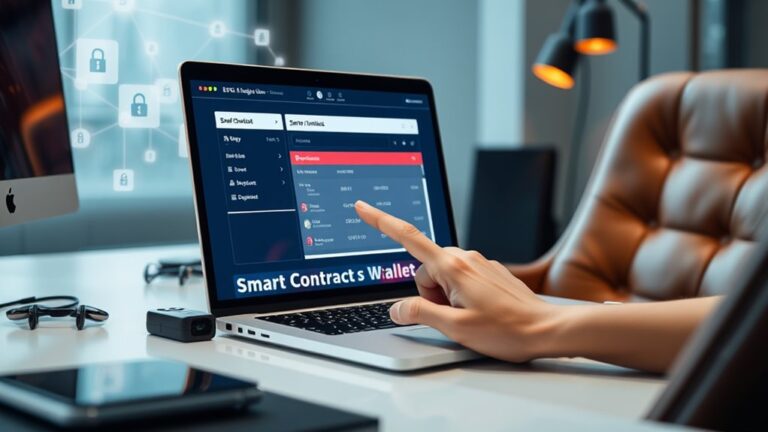
Recovering a Lost Crypto Wallet: A Step-by-Step Guide
Recovering a lost crypto wallet involves understanding wallet types and the critical role of seed phrases. Users should first look for their seed phrases, which are essential for restoring access. If the seed phrase is lost, alternative options include using private keys, backups, or professional recovery services. Prevention techniques, such as backing up seed phrases securely and implementing strong passwords, can help avoid future losses. Further steps can be explored to enhance security and recovery efforts effectively.
Key Takeaways
- Locate your seed phrase, as it is essential for wallet recovery and accessing your funds securely.
- If the seed phrase is missing, try restoring your wallet using backup files like wallet.dat or private keys.
- Utilize customer support from your wallet provider, as they may offer specific recovery options tailored to their service.
- Consider advanced recovery techniques like social recovery or Shamir’s Secret Sharing for enhanced security and accessibility.
- If all else fails, evaluate professional recovery services, ensuring they are reputable and understand the risks involved.
Understanding Different Types of Crypto Wallets

Crypto wallets play an essential role in the management of digital currencies, serving as storage solutions for private keys needed to access and transact with cryptocurrencies.
There are two main types of crypto wallets: custodial and non-custodial. Custodial wallets are managed by third parties, meaning users rely on external security measures. In contrast, non-custodial wallets are self-managed, placing the onus of security on the user. Non-custodial wallets generally offer better security due to user control of private keys, which mitigates the risks associated with third-party management.
Wallets can also be categorized as hot or cold. Hot wallets are connected to the internet and offer easier access, but they are more vulnerable to cyber threats. Cold wallets, however, store keys offline, providing enhanced security against hacking.
Each type has distinct features, advantages, and risks that users must consider when managing their digital assets.
The Importance of Seed Phrases

Why are seed phrases considered essential for cryptocurrency wallet management?
Seed phrases are important because they serve as the primary method for accessing and recovering cryptocurrency wallets. They consist of 12 to 24 words generated during wallet setup, making them user-friendly and secure.
The importance of seed phrases can be summarized with the following points:
- Wallet Recovery: They allow users to recover lost or stolen wallets efficiently.
- Investment Security: Seed phrases protect against unauthorized access to funds.
- Decentralization: They enable users to maintain control over their digital assets.
- Loss Prevention: Losing a seed phrase can lead to permanent loss of funds.
- Critical Vulnerability: Mismanagement can expose users to cybercrime risks.
Additionally, seed phrases are generated from a standard list of 2048 words, ensuring a high level of security through extensive possible combinations.
Understanding the significance of seed phrases is essential for all cryptocurrency users.
Recovery Options Without a Seed Phrase

Recovering a cryptocurrency wallet without a seed phrase presents significant challenges and risks. Users face notable difficulties, as traditional support options from wallet providers may not guarantee assistance.
An estimated $140 billion in Bitcoin remains inaccessible due to lost private keys or seed phrases, illustrating the stakes involved.
Recovery options include using private keys, if available, or restoring from backup files like wallet.dat. Multi-signature wallets may provide additional recovery methods, while data recovery tools can help retrieve lost wallet data. It’s also essential to consider strong, unique passwords and other security measures when attempting recovery to avoid further complications.
Contacting customer support can sometimes yield results, but help is often inconsistent. For those in dire situations, professional recovery services exist, though their success rates and costs vary, requiring careful consideration before pursuing such options.
Using Seed Phrases for Wallet Restoration

In order to restore access to a cryptocurrency wallet, users rely heavily on seed phrases, which serve as essential master keys for gaining entry to their digital assets. Understanding how to use these phrases is important for successful recovery.
Seed phrases are vital for accessing cryptocurrency wallets, making their proper use crucial for successful asset recovery.
Key points to keep in mind include:
- A seed phrase typically consists of 12, 18, or 24 words from a standardized list.
- Users must enter the words in the correct sequence for successful access.
- Storing seed phrases securely offline is critical to prevent hacking.
- Compatible wallets allow restoration on any device using the seed phrase.
- Errors in writing or entering the phrase can result in permanent asset loss.
Additionally, crypto wallets are crucial for securely interacting with the cryptocurrency ecosystem, emphasizing the importance of seed phrases in the recovery process.
Steps to Prevent Future Losses

Many individuals face the unfortunate reality of losing access to their cryptocurrency wallets, which can stem from various factors, including forgotten passwords or misplaced seed phrases.
To prevent future losses, it is essential to adopt secure storage practices. Individuals should keep physical copies of seed phrases and passwords in fireproof, waterproof safes, avoiding online storage.
Utilizing metal plates for recording keys and storing multiple copies in different locations can enhance security.
Best practices for wallet security include using strong passwords, enabling two-factor authentication, and regularly updating security software. Additionally, understanding common threats such as phishing attacks is crucial for protecting your assets.
When accessing wallets, a Virtual Private Network (VPN) is recommended, especially on public Wi-Fi.
Distributing assets across multiple wallet types further safeguards against potential losses in the future.
Common Scenarios Leading to Wallet Loss

Common scenarios leading to wallet loss often stem from device malfunction or loss, software corruption issues, and forgotten access credentials.
A hardware failure can render access to a wallet impossible, while corrupted software may lock users out of their funds.
Additionally, forgetting essential credentials such as passwords or recovery phrases can result in permanent loss if backups are not in place.
Device Malfunction or Loss
Device malfunction or loss can greatly impact the accessibility of cryptocurrency assets, often leading to frustrating situations for users. Several common causes contribute to this issue:
- Physical Damage: Hardware wallets can become unusable due to drops or impacts.
- Theft: Stolen devices create significant risks for asset security.
- Strong Magnetic Fields: Exposure to magnets can damage hardware wallets.
- Water or Fire Damage: Incidents like spills or fires can destroy devices.
- Component Failure: Internal issues from defects or wear can lead to malfunctions.
Understanding these risks is essential for users to implement protective measures. Regular backups, secure storage, and environmental protections can help mitigate potential losses, ensuring access to valuable cryptocurrency assets remains intact. Additionally, using a hardware wallet can further enhance security by keeping private keys offline and away from online threats.
Software Corruption Issues
Software corruption issues can lead to significant challenges for cryptocurrency wallet users, often resulting in loss of access to their assets.
Wallet corruption may occur due to faulty software or interrupted updates, making it impossible to retrieve crypto or NFTs. Additionally, malware infections can lock users out of their wallets or steal private keys by encrypting wallet files.
Failed system updates may also corrupt wallet access, highlighting the importance of regular backups.
Clipboard hijackers pose another risk, replacing copied wallet addresses with fraudulent ones, resulting in unintended transactions.
Finally, using outdated or pirated software lacks essential security patches, leaving wallets vulnerable to various attacks. Implementing strong passwords and two-factor authentication can help protect against unauthorized access.
Understanding these issues is vital for safeguarding cryptocurrency investments.
Forgotten Access Credentials
How often do users find themselves unable to access their cryptocurrency wallets due to forgotten access credentials? This situation can arise from several common scenarios:
- Misplaced notes containing login details.
- Forgotten email addresses used during account setup.
- Lack of two-factor authentication, which could aid recovery.
- Neglected updates to access credentials, leading to confusion.
- Overreliance on memory, which can fail under stress.
While the loss of login details may seem severe, recovery options often exist. Utilizing two-factor authentication, password managers, or contacting support can facilitate access restoration. Additionally, understanding the importance of secure wallet options is crucial in minimizing the risk of losing access to your funds.
However, maintaining secure and updated credentials is essential to prevent these issues from occurring in the first place, safeguarding users against potential disruptions in their crypto transactions.
Advanced Recovery Techniques

Advanced recovery techniques for lost crypto wallets include innovative methods such as social recovery, Shamir’s Secret Sharing, and blockchain forensics techniques.
Social recovery allows users to designate trusted contacts who can assist in regaining access, while Shamir’s Secret Sharing splits private keys into multiple parts for enhanced security.
Additionally, blockchain forensics techniques provide valuable insights into transaction history, aiding in the identification and recovery of lost assets.
Social Recovery Methods
While traditional recovery methods for crypto wallets often rely on single seed phrases or private keys, social recovery methods present an innovative alternative that leverages trusted social connections for backup. This approach enhances security and usability, making asset management more accessible.
Key aspects of social recovery include:
- Guardians: Trusted individuals designated for recovery.
- Threshold Mechanism: Required approval from multiple guardians for recovery.
- Decentralized Trust: Guardians do not need to know each other’s identities.
- User Control: Flexibility to add or remove guardians as needed.
- Timeouts: Delays on changes to prevent unauthorized alterations.
Prominent wallets like Argent and Loopring have adopted these features, promoting the potential for greater mainstream cryptocurrency adoption.
Shamir’s Secret Sharing
Shamir’s Secret Sharing, developed by Adi Shamir in 1979, provides a sophisticated method for securing recovery information in cryptocurrency wallets.
This technique utilizes a threshold mechanism, allowing users to determine how many shares are needed for recovery, such as a 2-of-3 or 3-of-5 configuration. By distributing shares among trusted parties or secure locations, it markedly enhances security and reduces the risk of a single point of failure.
Unlike traditional backups, Shamir’s method tolerates the loss of some shares, as long as the threshold is met. Typically, recovery shares consist of unique sequences of 20 or 33 words.
This approach is gaining traction in hardware wallets, like Trezor, for its adaptability and increased protection against loss and theft.
Blockchain Forensics Techniques
Blockchain forensics techniques serve as an essential tool for recovering lost crypto assets, particularly in cases where traditional recovery methods have failed.
These advanced methods leverage the unique properties of blockchain technology to track and analyze transactions. Key techniques include:
- Blockchain Transparency: Publicly recorded transactions allow detailed analysis.
- Suspect Wallet Identification: Identifying wallets involved in fraudulent activities is critical.
- Movement Tracking: Following funds across various wallets and exchanges.
- AI and Machine Learning: These technologies help detect hidden and suspicious transactions.
- Legal Cooperation: Collaborating with law enforcement can aid in freezing stolen assets.
Professional Recovery Services: What to Consider

When considering professional recovery services for a lost crypto wallet, individuals must carefully evaluate several important factors. The service’s reputation and success rate are essential, as positive client reviews indicate reliability.
Security and confidentiality should also be prioritized, with firms often using non-disclosure agreements to protect client data. It is important to verify which wallet types the service supports, including popular options like Bitcoin and Ethereum.
Legal compliance and collaboration with law enforcement can enhance recovery chances, especially in theft cases. Additionally, understanding the fee structure is vital; many services operate on a no-recovery-no-fee basis, ensuring clients only pay if successful recovery occurs.
Testing and Verifying Recovery Methods

Testing and verifying recovery methods is essential for guaranteeing that individuals can confidently restore access to their lost crypto wallets. This process not only enhances user confidence but also mitigates risks associated with faulty backups.
Key aspects to reflect upon include:
- Backup Verification: Guarantee backups are stored securely and accessible.
- Software Compatibility: Check that recovery software aligns with wallet requirements.
- Seed Phrase Accuracy: Confirm correct seed phrase usage to avoid recovery failures.
- Documentation Maintenance: Keep records of recovery steps for future reference.
- Simulated Loss Scenarios: Practice recovery in a controlled environment to identify potential issues.
Best Practices for Securing Your Crypto Wallet

Securing a crypto wallet is essential for anyone looking to protect their digital assets from theft and loss. Adopting best practices can greatly enhance security. Users should create strong passwords, store seed phrases offline, and enable two-factor authentication. Minimizing assets on trading platforms and avoiding public Wi-Fi are also vital steps. Additionally, employing multisig wallets can provide an extra layer of security by requiring multiple signatures for transactions.
| Best Practice | Description | Importance |
|---|---|---|
| Strong Passwords | Use complex passwords with alphanumeric characters. | Prevent unauthorized access. |
| Secure Seed Phrases | Keep them offline on paper or metal plates. | Protect against loss and theft. |
| Two-Factor Authentication | Add an extra layer of security. | Enhances overall wallet security. |
| Avoid Public Wi-Fi | Conduct transactions on secure networks. | Reduces the risk of data interception. |
Frequently Asked Questions
Can I Recover a Wallet Using Just My Private Key?
Recovering a wallet using only a private key is possible. This unique alphanumeric code grants access to associated funds, emphasizing the need for secure storage to prevent permanent loss if access is compromised.
What Should I Do if My Recovery Software Fails?
When recovery software falters, one must examine their surroundings like a detective in a dimly lit room. Exploring alternative methods—seed phrases, private keys, or expert services—may illuminate a path to reclaiming lost assets.
Are There Risks in Using Cloud Storage for Wallet Backups?
Using cloud storage for wallet backups presents risks, including hacking threats, phishing attacks, and loss of control. Additionally, service provider vulnerabilities and data loss risks necessitate careful management and robust security measures to safeguard sensitive information.
How Do I Know if My Wallet Has Been Compromised?
A user noticed unauthorized transactions draining their wallet’s balance, prompting concern. Signs of compromise include unexpected withdrawals, login anomalies, and unexplained changes in account settings, all indicating the need for immediate security reassessment and action.
Is It Possible to Recover a Wallet From a Damaged Hard Drive?
It is possible to recover a wallet from a damaged hard drive, depending on the extent of the damage. Professional recovery services utilize specialized techniques to restore lost data, though success varies by individual circumstances.
Conclusion
In the intricate landscape of cryptocurrency, recovering a lost wallet can be likened to traversing a labyrinth. With the right tools and knowledge, individuals can find their way back to their digital assets. By understanding wallet types, safeguarding seed phrases, and employing various recovery techniques, users can bolster their chances of successful retrieval. Ultimately, taking proactive steps to secure one’s wallet is essential, ensuring that the treasures of the digital domain remain safe from loss and despair.












